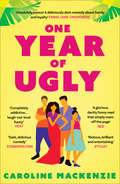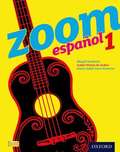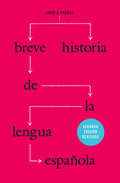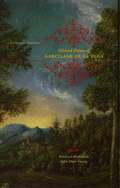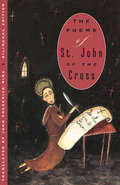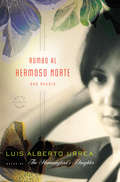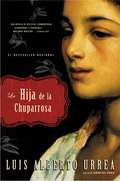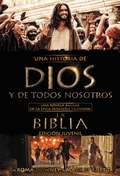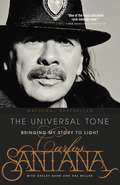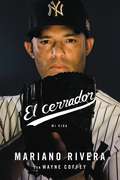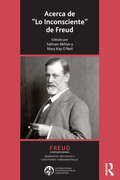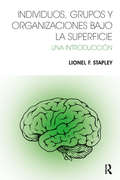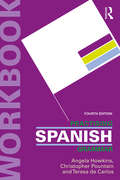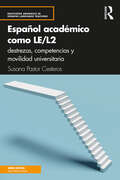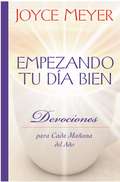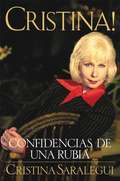- Table View
- List View
One Year of Ugly
by Caroline Mackenzie‘A glorious, darkly funny read that simply roars off the page’ RED magazine ‘Deliciously dark’ EMMA JANE UNSWORTH ‘Funny and important’ LAURA JANE WILLIAMS It was Aunt Celia who got us into the whole mess. The entire Palacios family thrust smack into the middle of a crime ring.
Zoom Español, Level 1 (PDF)
by Isabel Alonso de Sudea María Isabel Isern Vivancos Abigail HardwickZoom espanol is an inspiring two-part Spanish course offering fresh, exciting material and a fully-integrated video drama for the full ability range at Grades 6-8. There is a clear route through for students following both two-year and three-year courses so students and teachers know exactlyhow much material needs to be covered. Zoom espanol delivers the revised Grade 6-8 Programme of Study, PLTS and the Renewed Framework. The Zoom espanol course has a full suite of differentiated resources to support your needs: Student Books, Teacher Books, Foundation and Higher Workbooks, Audio CDs, Interactive OxBox CD-ROM and Assessment OxBox CD-ROM. The Zoom espanol 1 Student Book is full of inspiring activities to suit all learner types. Each unit links to a video clip and video-blog of four teenagers from Barcelona providing students with a real insight into Spanish-speaking people and their life. As well as plenty of engaging activities tosupport listening, reading, speaking and writing there are also pages in every unit dedicated to grammar, study skills and pronunciation support. Further cultural reading material is provided for every unit so that students can learn about life in Spain and Spanish-speaking countries.
Breve historia de la lengua española: Segunda edición revisada
by David A. PhariesPublicada inicialmente en 2007, esta Breve historia de la lengua española se ha convertido en la introducción más difundida a una de las lenguas más importantes del mundo por la extensión de su dominio y el número de hablantes. Este libro ofrece al lector un relato conciso que se propone profundizar en la evolución de la lengua desde sus raíces latinas hasta el presente, prestando especial atención a los cambios históricos y culturales que contribuyeron a su evolución y propagación por el mundo. La Breve historia de la lengua española se concentra en los cambios más importantes de la evolución de la lengua, evitando la jerga académica ininteligible y favoreciendo la claridad en las explicaciones. Por el camino, intenta dar respuesta a muchas de las preguntas que con frecuencia desconciertan a los hablantes nativos y no nativos: ¿Por qué se utiliza tú en algunos lugares y vos en otros? ¿Cómo surgió la pronunciación como fricativa interdental de la zeta castellana? ¿Por qué se dice la mesa pero el agua con un artículo que parece masculino? David A. Pharies es un experto en el estudio de la historia y evolución del español, que goza de un reconocido prestigio en la escena internacional. Para actualizar esta segunda edición ha revisado en profundidad todos los aspectos de la evolución del español, incluido su desarrollo demográfico. El libro va dirigido a quienes tienen un conocimiento básico del español y desean aprender más sobre sus orígenes. También constituye una base ideal para emprender el estudio de cualquier aspecto de la lingüística histórica española y de la literatura medieval. Entretenida y accesible, la Breve historia de la lengua española es un gran viaje de descubrimiento en una presentación amena y sucinta. Since its publication in 2007, A Brief History of the Spanish Language has become the leading introduction to the history of one of the world’s most widely spoken languages. Moving from the language’s Latin roots to its present-day forms, this concise book offers readers insights into the origin and evolution of Spanish, the historical and cultural changes that shaped it, and its spread around the world. A Brief History of the Spanish Language focuses on the most important aspects of the development of the Spanish language, eschewing technical jargon in favor of straightforward explanations. Along the way, it answers many of the common questions that puzzle native and nonnative speakers alike, such as: Why do some regions use tú while others use vos? How did the th sound develop in Castilian? And why is it la mesa but el agua? David A. Pharies, an internationally recognized expert on the history and development of Spanish, has updated this edition with new research on all aspects of the evolution of Spanish while adding current demographic information as well. This book is perfect for anyone with a basic understanding of Spanish and a desire to further explore its roots. It also provides an ideal foundation for further study in any area of historical Spanish linguistics and early Spanish literature. Both absorbing and accessible, A Brief History of the Spanish Language is a grand journey of discovery in a beautifully compact format.
Breve historia de la lengua española: Segunda edición revisada
by David A. PhariesPublicada inicialmente en 2007, esta Breve historia de la lengua española se ha convertido en la introducción más difundida a una de las lenguas más importantes del mundo por la extensión de su dominio y el número de hablantes. Este libro ofrece al lector un relato conciso que se propone profundizar en la evolución de la lengua desde sus raíces latinas hasta el presente, prestando especial atención a los cambios históricos y culturales que contribuyeron a su evolución y propagación por el mundo. La Breve historia de la lengua española se concentra en los cambios más importantes de la evolución de la lengua, evitando la jerga académica ininteligible y favoreciendo la claridad en las explicaciones. Por el camino, intenta dar respuesta a muchas de las preguntas que con frecuencia desconciertan a los hablantes nativos y no nativos: ¿Por qué se utiliza tú en algunos lugares y vos en otros? ¿Cómo surgió la pronunciación como fricativa interdental de la zeta castellana? ¿Por qué se dice la mesa pero el agua con un artículo que parece masculino? David A. Pharies es un experto en el estudio de la historia y evolución del español, que goza de un reconocido prestigio en la escena internacional. Para actualizar esta segunda edición ha revisado en profundidad todos los aspectos de la evolución del español, incluido su desarrollo demográfico. El libro va dirigido a quienes tienen un conocimiento básico del español y desean aprender más sobre sus orígenes. También constituye una base ideal para emprender el estudio de cualquier aspecto de la lingüística histórica española y de la literatura medieval. Entretenida y accesible, la Breve historia de la lengua española es un gran viaje de descubrimiento en una presentación amena y sucinta. Since its publication in 2007, A Brief History of the Spanish Language has become the leading introduction to the history of one of the world’s most widely spoken languages. Moving from the language’s Latin roots to its present-day forms, this concise book offers readers insights into the origin and evolution of Spanish, the historical and cultural changes that shaped it, and its spread around the world. A Brief History of the Spanish Language focuses on the most important aspects of the development of the Spanish language, eschewing technical jargon in favor of straightforward explanations. Along the way, it answers many of the common questions that puzzle native and nonnative speakers alike, such as: Why do some regions use tú while others use vos? How did the th sound develop in Castilian? And why is it la mesa but el agua? David A. Pharies, an internationally recognized expert on the history and development of Spanish, has updated this edition with new research on all aspects of the evolution of Spanish while adding current demographic information as well. This book is perfect for anyone with a basic understanding of Spanish and a desire to further explore its roots. It also provides an ideal foundation for further study in any area of historical Spanish linguistics and early Spanish literature. Both absorbing and accessible, A Brief History of the Spanish Language is a grand journey of discovery in a beautifully compact format.
Breve historia de la lengua española: Segunda edición revisada
by David A. PhariesPublicada inicialmente en 2007, esta Breve historia de la lengua española se ha convertido en la introducción más difundida a una de las lenguas más importantes del mundo por la extensión de su dominio y el número de hablantes. Este libro ofrece al lector un relato conciso que se propone profundizar en la evolución de la lengua desde sus raíces latinas hasta el presente, prestando especial atención a los cambios históricos y culturales que contribuyeron a su evolución y propagación por el mundo. La Breve historia de la lengua española se concentra en los cambios más importantes de la evolución de la lengua, evitando la jerga académica ininteligible y favoreciendo la claridad en las explicaciones. Por el camino, intenta dar respuesta a muchas de las preguntas que con frecuencia desconciertan a los hablantes nativos y no nativos: ¿Por qué se utiliza tú en algunos lugares y vos en otros? ¿Cómo surgió la pronunciación como fricativa interdental de la zeta castellana? ¿Por qué se dice la mesa pero el agua con un artículo que parece masculino? David A. Pharies es un experto en el estudio de la historia y evolución del español, que goza de un reconocido prestigio en la escena internacional. Para actualizar esta segunda edición ha revisado en profundidad todos los aspectos de la evolución del español, incluido su desarrollo demográfico. El libro va dirigido a quienes tienen un conocimiento básico del español y desean aprender más sobre sus orígenes. También constituye una base ideal para emprender el estudio de cualquier aspecto de la lingüística histórica española y de la literatura medieval. Entretenida y accesible, la Breve historia de la lengua española es un gran viaje de descubrimiento en una presentación amena y sucinta. Since its publication in 2007, A Brief History of the Spanish Language has become the leading introduction to the history of one of the world’s most widely spoken languages. Moving from the language’s Latin roots to its present-day forms, this concise book offers readers insights into the origin and evolution of Spanish, the historical and cultural changes that shaped it, and its spread around the world. A Brief History of the Spanish Language focuses on the most important aspects of the development of the Spanish language, eschewing technical jargon in favor of straightforward explanations. Along the way, it answers many of the common questions that puzzle native and nonnative speakers alike, such as: Why do some regions use tú while others use vos? How did the th sound develop in Castilian? And why is it la mesa but el agua? David A. Pharies, an internationally recognized expert on the history and development of Spanish, has updated this edition with new research on all aspects of the evolution of Spanish while adding current demographic information as well. This book is perfect for anyone with a basic understanding of Spanish and a desire to further explore its roots. It also provides an ideal foundation for further study in any area of historical Spanish linguistics and early Spanish literature. Both absorbing and accessible, A Brief History of the Spanish Language is a grand journey of discovery in a beautifully compact format.
Breve historia de la lengua española: Segunda edición revisada
by David A. PhariesPublicada inicialmente en 2007, esta Breve historia de la lengua española se ha convertido en la introducción más difundida a una de las lenguas más importantes del mundo por la extensión de su dominio y el número de hablantes. Este libro ofrece al lector un relato conciso que se propone profundizar en la evolución de la lengua desde sus raíces latinas hasta el presente, prestando especial atención a los cambios históricos y culturales que contribuyeron a su evolución y propagación por el mundo. La Breve historia de la lengua española se concentra en los cambios más importantes de la evolución de la lengua, evitando la jerga académica ininteligible y favoreciendo la claridad en las explicaciones. Por el camino, intenta dar respuesta a muchas de las preguntas que con frecuencia desconciertan a los hablantes nativos y no nativos: ¿Por qué se utiliza tú en algunos lugares y vos en otros? ¿Cómo surgió la pronunciación como fricativa interdental de la zeta castellana? ¿Por qué se dice la mesa pero el agua con un artículo que parece masculino? David A. Pharies es un experto en el estudio de la historia y evolución del español, que goza de un reconocido prestigio en la escena internacional. Para actualizar esta segunda edición ha revisado en profundidad todos los aspectos de la evolución del español, incluido su desarrollo demográfico. El libro va dirigido a quienes tienen un conocimiento básico del español y desean aprender más sobre sus orígenes. También constituye una base ideal para emprender el estudio de cualquier aspecto de la lingüística histórica española y de la literatura medieval. Entretenida y accesible, la Breve historia de la lengua española es un gran viaje de descubrimiento en una presentación amena y sucinta. Since its publication in 2007, A Brief History of the Spanish Language has become the leading introduction to the history of one of the world’s most widely spoken languages. Moving from the language’s Latin roots to its present-day forms, this concise book offers readers insights into the origin and evolution of Spanish, the historical and cultural changes that shaped it, and its spread around the world. A Brief History of the Spanish Language focuses on the most important aspects of the development of the Spanish language, eschewing technical jargon in favor of straightforward explanations. Along the way, it answers many of the common questions that puzzle native and nonnative speakers alike, such as: Why do some regions use tú while others use vos? How did the th sound develop in Castilian? And why is it la mesa but el agua? David A. Pharies, an internationally recognized expert on the history and development of Spanish, has updated this edition with new research on all aspects of the evolution of Spanish while adding current demographic information as well. This book is perfect for anyone with a basic understanding of Spanish and a desire to further explore its roots. It also provides an ideal foundation for further study in any area of historical Spanish linguistics and early Spanish literature. Both absorbing and accessible, A Brief History of the Spanish Language is a grand journey of discovery in a beautifully compact format.
Selected Poems of Garcilaso de la Vega: A Bilingual Edition
by Garcilaso de la VegaGarcilaso de la Vega (ca. 1501–36), a Castilian nobleman and soldier at the court of Charles V, lived a short but glamorous life. As the first poet to make the Italian Renaissance lyric style at home in Spanish, he is credited with beginning the golden age of Spanish poetry. Known for his sonnets and pastorals, gracefully depicting beauty and love while soberly accepting their passing, he is shown here also as a calm student of love’s psychology and a critic of the savagery of war. This bilingual volume is the first in nearly two hundred years to fully represent Garcilaso for an Anglophone readership. In facing-page translations that capture the music and skill of Garcilaso’s verse, John-Dent Young presents the sonnets, songs, elegies, and eclogues that came to influence generations of poets, including San Juan de la Cruz, Luis de Leon, Cervantes, and Góngora. The Selected Poems of Garcilaso de la Vega will help to explain to the English-speaking public this poet’s preeminence in the pantheon of Spanish letters.
Selected Poems of Garcilaso de la Vega: A Bilingual Edition
by Garcilaso de la VegaGarcilaso de la Vega (ca. 1501–36), a Castilian nobleman and soldier at the court of Charles V, lived a short but glamorous life. As the first poet to make the Italian Renaissance lyric style at home in Spanish, he is credited with beginning the golden age of Spanish poetry. Known for his sonnets and pastorals, gracefully depicting beauty and love while soberly accepting their passing, he is shown here also as a calm student of love’s psychology and a critic of the savagery of war. This bilingual volume is the first in nearly two hundred years to fully represent Garcilaso for an Anglophone readership. In facing-page translations that capture the music and skill of Garcilaso’s verse, John-Dent Young presents the sonnets, songs, elegies, and eclogues that came to influence generations of poets, including San Juan de la Cruz, Luis de Leon, Cervantes, and Góngora. The Selected Poems of Garcilaso de la Vega will help to explain to the English-speaking public this poet’s preeminence in the pantheon of Spanish letters.
The Poems of St. John of the Cross: Spiritual Canticle, Poems
by St. John of the CrossSan Juan de la Cruz, the great sixteenth-century Spanish mystic, is regarded by many as Spain's finest poet. Passionate, ecstatic, and spiritual, his poems are a blend of exquisite lyricism and profound mystical thought. In The Poems of St. John of the Cross John Frederick Nims presents his superlative translation of the complete poems, re-creating the religious fervor of St. John's art. This dual-language edition makes available the original Spanish from the Codex of Sanlúcon de Barrameda with facing English translations. The work concludes with two essays—a critique of the poetry and a short piece on the Spanish text that appears alongside the translation—as well as brief notes on the individual poems.
Rumbo al Hermoso Norte: A Novel
by Luis Alberto UrreaNineteen-year-old Nayeli works at a taco shop in her Mexican village and dreams about her father, who journeyed to the US to find work. Recently, it has dawned on her that he isn't the only man who has left town. In fact, there are almost no men in the village -- they've all gone north. While watching The Magnificent Seven, Nayeli decides to go north herself and recruit seven men -- her own "Siete Magnv?ficos" -- to repopulate her hometown and protect it from the bandidos who plan on taking it over. Filled with unforgettable characters and prose as radiant as the Sinaloan sun, Into the Beautiful North is the story of an irresistible young woman's quest to find herself on both sides of the fence.
La Hija de la Chuparrosa
by Luis Alberto UrreaDiscover an epic historical novel of a young saint escaping death from Pulitzer Prize finalist Luis Alberto Urrea, author of The House of Broken Angels. This historical novel is based on Urrea's real great-aunt Teresita, who had healing powers and was acclaimed as a saint. Urrea has researched historical accounts and family records for years to get an accurate story.
Una historia de Dios y de todos nosotros edición juvenil: Una novela basada en la épica miniserie televisiva La Biblia
by Roma Downey Mark BurnettA STORY OF GOD AND ALL OF US is a sweeping narrative that dramatizes some of the most important events and characters in the Bible. The young reader's edition of the novel contains abridged action-packed versions of the Bible's most fascinating stories, featuring Moses, David, Daniel, John the Baptist and Jesus.This edition includes an exclusive introduction by author Roma Downey and a photo insert including images from the companion epic TV miniseries "The Bible."
El Tono Universal: Sacando mi Historia a la Luz
by Carlos SantanaThe intimate and long-awaited autobiography of a legend. In 1967 in San Francisco, just a few weeks after the Summer of Love, a young Mexican guitarist took the stage at the Fillmore Auditorium and played a blistering solo that announced the arrival of a prodigious musical talent. Two years later -- after he played a historic set at Woodstock -- the world came to know the name Carlos Santana, his sensual and instantly recognizable guitar sound, and the legendary band that blended electric blues, psychedelic rock, Latin rhythms, and modern jazz, and that still bears his name. Carlos Santana's unforgettable memoir offers a page-turning tale of musical self-determination and inner self-discovery, with personal stories filled with colorful detail and life-affirming lessons. The Universal Tone traces his journey from his earliest days playing the strip bars in Tijuana while barely in his teens and brings to light the establishment of his signature guitar sound; his roles as husband, father, recording legend, and rock guitar star; his indebtedness to musical and spiritual influences -- from John Coltrane and John Lee Hooker to Miles Davis and Harry Belafonte; and his deep, lifelong dedication to a spiritual path that he developed from his Catholic upbringing, Eastern philosophies, and other mystical sources. It includes his recording some of the most popular and influential rock albums of all time, up to and beyond the 1999 sensation Supernatural, which garnered nine Grammy Awards and stands as arguably the most amazing career comeback in popular music history. It's a profoundly inspiring tale of divine inspiration and musical fearlessness that does not balk at finding the humor in the world of high-flying fame, or at speaking plainly of Santana's personal revelations and the infinite possibility he sees in each person he meets. "Love is the light that is inside of all of us, everyone," he writes. "I salute the light that you are and that is inside your heart."
El cerrador: Mi vida
by Mariano RiveraThe greatest relief pitcher of all time shares his extraordinary story of survival, love, and baseball. Mariano Rivera, the man who intimidated thousands of batters merely by opening a bullpen door, began his incredible journey as the son of a poor Panamanian fisherman. When first scouted by the Yankees, he didn't even own his own glove. He thought he might make a good mechanic. When discovered, he had never flown in an airplane, had never heard of Babe Ruth, spoke no English, and couldn't imagine Tampa, the city where he was headed to begin a career that would become one of baseball's most iconic. What he did know: that he loved his family and his then girlfriend, Clara, that he could trust in the Lord to guide him, and that he could throw a baseball exactly where he wanted to, every time. With astonishing candor, Rivera tells the story of the championships, the bosses (including The Boss), the rivalries, and the struggles of being a Latino baseball player in the United States and of maintaining Christian values in professional athletics. The thirteen-time All-Star discusses his drive to win; the secrets behind his legendary composure; the story of how he discovered his cut fastball; the untold, pitch-by-pitch account of the ninth inning of Game 7 in the 2001 World Series; and why the lowest moment of his career became one of his greatest blessings. In The Closer, Rivera takes readers into the Yankee clubhouse, where his teammates are his brothers. But he also takes us on that jog from the bullpen to the mound, where the game -- or the season -- rests squarely on his shoulders. We come to understand the laserlike focus that is his hallmark, and how his faith and his family kept his feet firmly on the pitching rubber. Many of the tools he used so consistently and gracefully came from what was inside him for a very long time -- his deep passion for life; his enduring commitment to Clara, whom he met in kindergarten; and his innate sense for getting out of a jam. When Rivera retired, the whole world watched -- and cheered. In The Closer, we come to an even greater appreciation of a legend built from the ground up.
El cerrador: Mi vida
by Mariano RiveraThe greatest relief pitcher of all time shares his extraordinary story of survival, love, and baseball. Mariano Rivera, the man who intimidated thousands of batters merely by opening a bullpen door, began his incredible journey as the son of a poor Panamanian fisherman. When first scouted by the Yankees, he didn't even own his own glove. He thought he might make a good mechanic. When discovered, he had never flown in an airplane, had never heard of Babe Ruth, spoke no English, and couldn't imagine Tampa, the city where he was headed to begin a career that would become one of baseball's most iconic. What he did know: that he loved his family and his then girlfriend, Clara, that he could trust in the Lord to guide him, and that he could throw a baseball exactly where he wanted to, every time. With astonishing candor, Rivera tells the story of the championships, the bosses (including The Boss), the rivalries, and the struggles of being a Latino baseball player in the United States and of maintaining Christian values in professional athletics. The thirteen-time All-Star discusses his drive to win; the secrets behind his legendary composure; the story of how he discovered his cut fastball; the untold, pitch-by-pitch account of the ninth inning of Game 7 in the 2001 World Series; and why the lowest moment of his career became one of his greatest blessings. In The Closer, Rivera takes readers into the Yankee clubhouse, where his teammates are his brothers. But he also takes us on that jog from the bullpen to the mound, where the game -- or the season -- rests squarely on his shoulders. We come to understand the laserlike focus that is his hallmark, and how his faith and his family kept his feet firmly on the pitching rubber. Many of the tools he used so consistently and gracefully came from what was inside him for a very long time -- his deep passion for life; his enduring commitment to Clara, whom he met in kindergarten; and his innate sense for getting out of a jam. When Rivera retired, the whole world watched -- and cheered. In The Closer, we come to an even greater appreciation of a legend built from the ground up.
Acerca de Lo Inconsciente de Freud
by Salman Akhtar Mary Kay O'Neil Jose Maria VacaIf there ever was one word that could represent the essence of Freud's work, that word would be 'unconscious'. Indeed, Freud himself regarded his 1915 paper 'The Unconscious' as central to clarifying the fundamentals of his metapsychology. The paper delineates the topographic model of the mind and spells out the concepts of primary and secondary process thinking, thing and word presentations, timelessness of the unconscious, condensation and symbolism, unconscious problem solving, and the relationship between the system Ucs and repression. Examining these proposals in the light of contemporary psychoanalytic theory as well as from the perspective of current neurophysiology and ethology, nine distinguished analysts take Freud's ideas further in ways that have implications for both psychoanalytic theory and practice.
Individuos, Grupos y Organizaciones Bajo La Superficie: Una Introduccion
by Lionel F Stapley Jose Maria Ruiz VacaThis volume is an introductory text to the individual and organizational dynamics by an author with extensive experience in the field. It examines the unconscious processes of human behavior that affect all organizations and institutions. It is aimed at those who are currently employed as managers or consultants, management students, and others wit
Acerca de Lo Inconsciente de Freud
by Salman Akhtar Mary Kay O'Neil Jose Maria VacaIf there ever was one word that could represent the essence of Freud's work, that word would be 'unconscious'. Indeed, Freud himself regarded his 1915 paper 'The Unconscious' as central to clarifying the fundamentals of his metapsychology. The paper delineates the topographic model of the mind and spells out the concepts of primary and secondary process thinking, thing and word presentations, timelessness of the unconscious, condensation and symbolism, unconscious problem solving, and the relationship between the system Ucs and repression. Examining these proposals in the light of contemporary psychoanalytic theory as well as from the perspective of current neurophysiology and ethology, nine distinguished analysts take Freud's ideas further in ways that have implications for both psychoanalytic theory and practice.
Individuos, Grupos y Organizaciones Bajo La Superficie: Una Introduccion
by Lionel F Stapley Jose Maria Ruiz VacaThis volume is an introductory text to the individual and organizational dynamics by an author with extensive experience in the field. It examines the unconscious processes of human behavior that affect all organizations and institutions. It is aimed at those who are currently employed as managers or consultants, management students, and others wit
Practising Spanish Grammar (Practising Grammar Workbooks)
by Angela Howkins Christopher Pountain Teresa de CarlosPractising Spanish Grammar can be used independently or as the ideal companion to the sixth edition of the widely acclaimed A New Reference Grammar of Modern Spanish (Butt, Benjamin and Moreira Rodríguez). Thoroughly updated, this fourth edition of the workbook features an improved organization which closely mirrors that of A New Reference Grammar of Modern Spanish, sixth edition. The selection of exercises has been fully revised and expanded with new exercises on a variety of topics including possessives, conditional, future and past tenses, and polite requests. Designed to stimulate and engage even the most grammar-shy students, this is an ideal resource for Spanish learners at CEFR Level B2–C1, ACFTL Intermediate-High to Advanced.
Practising Spanish Grammar (Practising Grammar Workbooks)
by Angela Howkins Christopher Pountain Teresa De CarlosPractising Spanish Grammar can be used independently or as the ideal companion to the sixth edition of the widely acclaimed A New Reference Grammar of Modern Spanish (Butt, Benjamin and Moreira Rodríguez). Thoroughly updated, this fourth edition of the workbook features an improved organization which closely mirrors that of A New Reference Grammar of Modern Spanish, sixth edition. The selection of exercises has been fully revised and expanded with new exercises on a variety of topics including possessives, conditional, future and past tenses, and polite requests. Designed to stimulate and engage even the most grammar-shy students, this is an ideal resource for Spanish learners at CEFR Level B2–C1, ACFTL Intermediate-High to Advanced.
Español académico como LE/L2: destrezas, competencias y movilidad universitaria (Routledge Advances in Spanish Language Teaching)
by Susana Pastor CesterosEspañol académico como LE/L2: destrezas, competencias y movilidad universitaria ofrece una completa visión del área del español académico como LE/L2 en la educación superior. Escrito en español, este libro aborda las prácticas letradas académicas en el mundo hispánico tanto en el aula como en la investigación. Combina una orientación teórico-práctica, con pautas y herramientas para ayudar a los aprendices de español a comunicarse en contexto académico universitario. Entre las características principales del libro se incluyen: Información para cubrir las necesidades educativas de estudiantes internacionales de grado y posgrado en universidades de habla hispana. Secuenciación de contenidos para favorecer la enseñanza del lenguaje académico a estudiantes con lenguas maternas, perfiles lingüísticos y tradiciones culturales académicas diferentes. Análisis de los géneros orales y escritos académicos: interacción en el aula, presentaciones orales, comunicaciones en congresos, ensayos, reseñas, exámenes escritos, trabajos de investigación, defensas... Abundantes ejemplos, actividades y recursos en cada capítulo. Pautas curriculares para planificar cursos de español académico y otras intervenciones didácticas, en distintos contextos de aprendizaje. Perspectiva global del español académico para estudiantes no nativos, que incluye a las universidades tanto españolas como hispanoamericanas. Español académico como LE/L2 es una obra de referencia para docentes de español como L2, formadores del profesorado, estudiantes de español nativos y no nativos, así como para cualquier persona interesada en el español académico. Español académico como LE/L2: destrezas, competencias y movilidad universitaria offers a comprehensive overview of Academic Spanish as a FL/L2 in Higher Education. Written in Spanish, this book deals with academic literacy practices in the Hispanic world, both in the classroom and in research. It combines a theoretical-practical orientation, with guidelines and tools, to help Spanish learners to communicate in an academic context of higher education. Main features of this book include: • Information to fulfill the educational needs of undergraduate and graduate international mobility students in Spanish-speaking universities. • Content planning to improve the teaching of academic Spanish to students with different mother tongues, linguistic profiles and academic cultural traditions. • Analysis of oral and written academic genres: interaction in the classroom, oral presentations, papers, essays, reviews, written exams, thesis, and defenses. • Abundant examples, activities and resources in each chapter. • Curricular guidelines for planning academic Spanish courses and other didactic interventions in different learning contexts. • Global perspective of academic Spanish for non-native students, which includes both Spanish and Latin American universities. Español académico como LE/L2 is the ideal reference work for teachers, teacher trainers and students of the Spanish language, both native and non-native speakers, as well as those interested in academic Spanish.
Español académico como LE/L2: destrezas, competencias y movilidad universitaria (Routledge Advances in Spanish Language Teaching)
by Susana Pastor CesterosEspañol académico como LE/L2: destrezas, competencias y movilidad universitaria ofrece una completa visión del área del español académico como LE/L2 en la educación superior. Escrito en español, este libro aborda las prácticas letradas académicas en el mundo hispánico tanto en el aula como en la investigación. Combina una orientación teórico-práctica, con pautas y herramientas para ayudar a los aprendices de español a comunicarse en contexto académico universitario. Entre las características principales del libro se incluyen: Información para cubrir las necesidades educativas de estudiantes internacionales de grado y posgrado en universidades de habla hispana. Secuenciación de contenidos para favorecer la enseñanza del lenguaje académico a estudiantes con lenguas maternas, perfiles lingüísticos y tradiciones culturales académicas diferentes. Análisis de los géneros orales y escritos académicos: interacción en el aula, presentaciones orales, comunicaciones en congresos, ensayos, reseñas, exámenes escritos, trabajos de investigación, defensas... Abundantes ejemplos, actividades y recursos en cada capítulo. Pautas curriculares para planificar cursos de español académico y otras intervenciones didácticas, en distintos contextos de aprendizaje. Perspectiva global del español académico para estudiantes no nativos, que incluye a las universidades tanto españolas como hispanoamericanas. Español académico como LE/L2 es una obra de referencia para docentes de español como L2, formadores del profesorado, estudiantes de español nativos y no nativos, así como para cualquier persona interesada en el español académico. Español académico como LE/L2: destrezas, competencias y movilidad universitaria offers a comprehensive overview of Academic Spanish as a FL/L2 in Higher Education. Written in Spanish, this book deals with academic literacy practices in the Hispanic world, both in the classroom and in research. It combines a theoretical-practical orientation, with guidelines and tools, to help Spanish learners to communicate in an academic context of higher education. Main features of this book include: • Information to fulfill the educational needs of undergraduate and graduate international mobility students in Spanish-speaking universities. • Content planning to improve the teaching of academic Spanish to students with different mother tongues, linguistic profiles and academic cultural traditions. • Analysis of oral and written academic genres: interaction in the classroom, oral presentations, papers, essays, reviews, written exams, thesis, and defenses. • Abundant examples, activities and resources in each chapter. • Curricular guidelines for planning academic Spanish courses and other didactic interventions in different learning contexts. • Global perspective of academic Spanish for non-native students, which includes both Spanish and Latin American universities. Español académico como LE/L2 is the ideal reference work for teachers, teacher trainers and students of the Spanish language, both native and non-native speakers, as well as those interested in academic Spanish.
Empezando Tu D a Bien: Devociones para Cada Mañana del Año
by Joyce MeyerMany people start their day off with a few minutes of prayer and Bible study, often with a devotion. But how many of them take the time at night to spend a moment with God after their hurried bedtime prayers. This companion to 'Starting Your Day Right' asks for God's continued care throughout the night.
Cristina!: Confidencias de Una Rubia
by Cristina SaraleguiMeet Cristina the superstar. The granddaughter of the foremost publishing czar in Cuba, she fled as an adolescent to the United States after the revolution. A young woman working her way up through the ranks of the North American-based Spanish-language media, she eventually assumed the reins of Cosmopolitan en Espanol. After ten years with Cosmopolitan, Cristina made the boldest move of her career - creating and hosting El Show de Cristina, the talk show she has developed into the phenomenon seen by 100 million worldwide. Friend and confidante to celebrities both inside and outside the Hispanic world, she also hosts a radio show heard all over Latin America and publishes the magazine Cristina La Revista, read avidly by thousands of fans every month. Meet Cristina the Motivator. Groundbreaker and role model for women everywhere - especially Latinas - she offers advice, based on the life she has lived and the wisdom she has earned, on overcoming racial and sexual discrimination...raising children...keeping a happy marriage...growing older gracefully...and the Winner's Ten Commandments.
